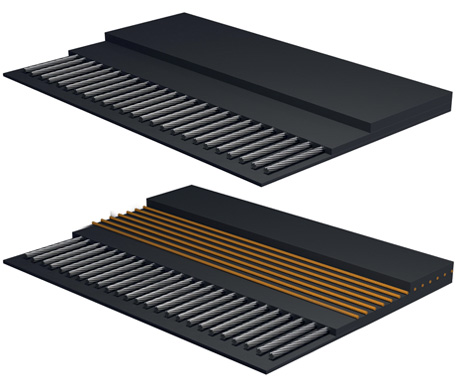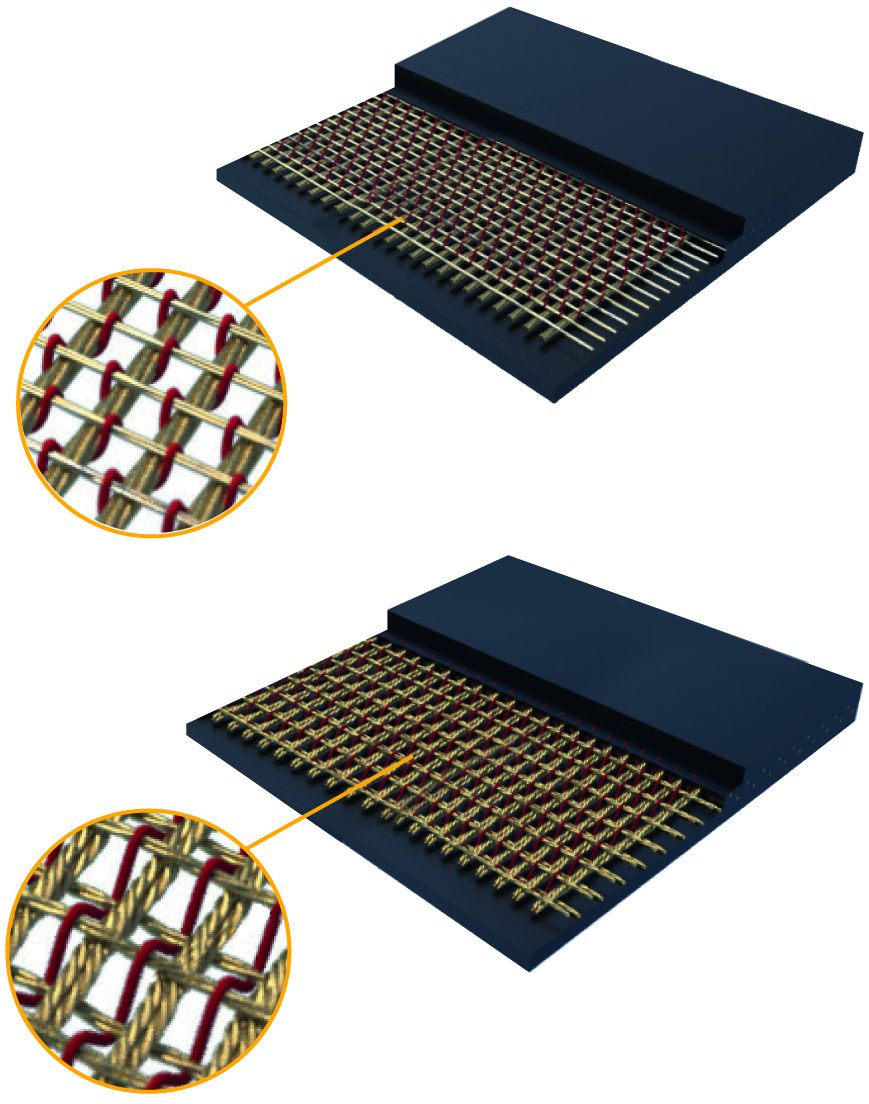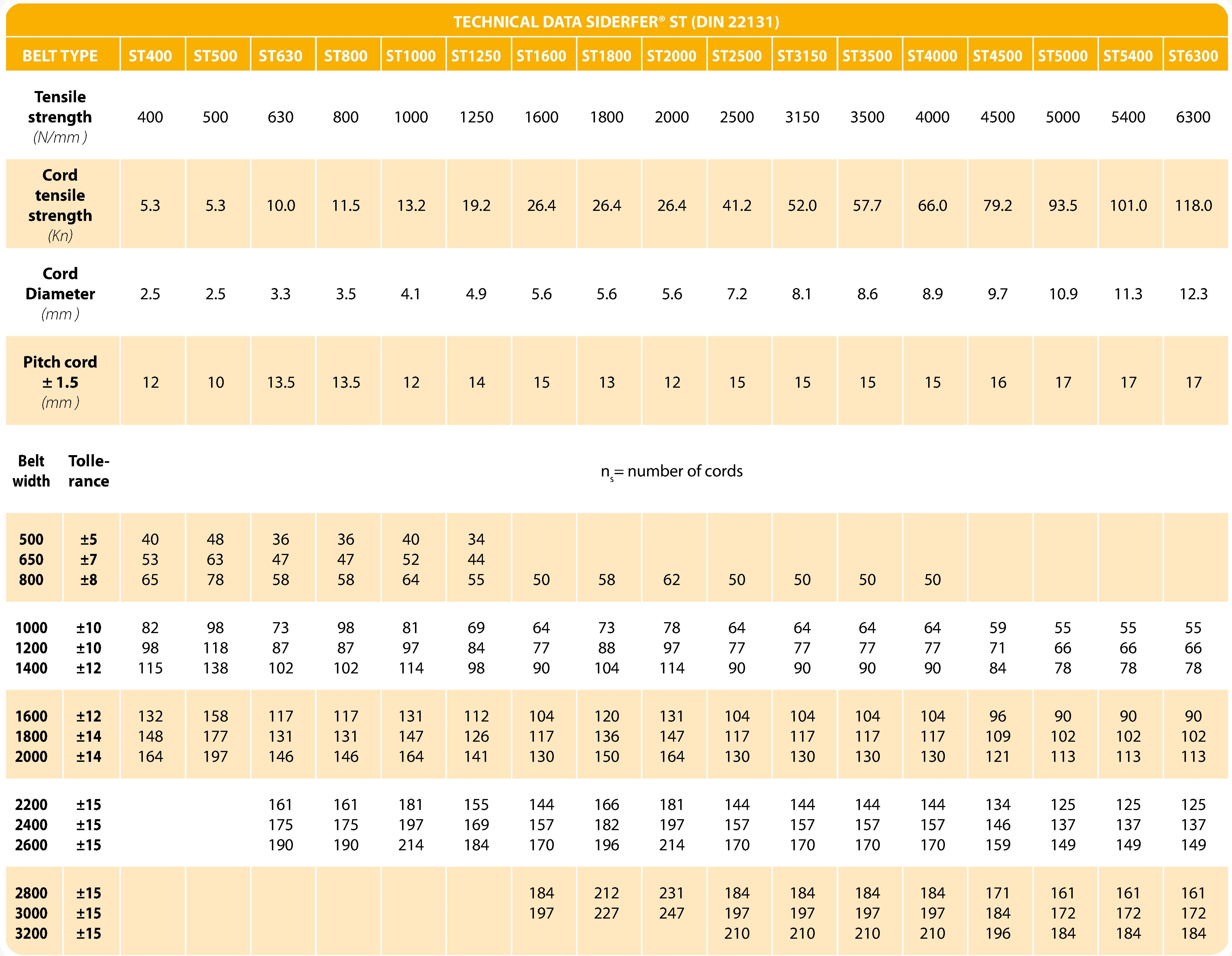The high specific load of the SIDERFER® steel structures allows conveyors to be installed with long center distances, on the order of 15 Km. SIDERFER® structures allow the belt to perfectly adapt to even very concave supporting stations.
Lengthwise flexibility permits use of small diameter drums. The size stability of the SIDERFER® carcass ensures perfect running straightness and high operating speeds.
The elasticity characteristics of the metal carcasses and the high level of bonding between carcass and rubber give our SIDERFER® belts excellent impact resistance caused by falling materials on the belt, extending their application area to include conveyance of heavy and large-size materials.
These belts come in three types:
- SIDERFER® ST
- SIDERFER® IW
- SIDERFER® SW
Rubber covers are designed and selected according to specific requirements of the plant and the material being conveyed. Special attention is focused on:
- Degree of abrasiveness and material sizes
- Material size Material temperature
- Presence of oil, grease, solvents, hydrocarbons, aggressive chemicals etc.
- Extreme environmental conditions such as low temperature
 SIDERFER® ST belts are made of:
SIDERFER® ST belts are made of:
Special high carbon content steel strand cords.
Special heat treatment makes the cord highly resistant to breakage and repeated dynamic stresses as well as highly flexible.Diameters of the strand wires vary from 0.25 to 0.7 mm and ensure strength of up to 260 Kg/mm2.
These cords are hot galvanized to protect them against corrosion and
ensure good bonding with the rubber.
The carcass is made by inserting the uniformly taut cords into a
rubber sheet with direct bonding.
The cords are laid parallel into the carcass at even pitches, perfectly co-planar and alternating layouts with “S” and “Z” windings.
Carcasses made in this way ensure:
- Total cord collaboration
- Great resistance to repeated dynamic stresses
- Perfect running stability
- Exceptional features of lengthwise and transverse flexibility
- High resistance to removal of the cords from the rubber
SIDERFER® ST belts are produced with molded edges.
Standard covers: N, Y, X, HR-150, K, G, S, GS (see cover table).
The FLEXOTEC® protection system makes SIDERFER® ST belts the leaders in increased impact resistance. Synthetic fiber cords, with 1.5 2.5 3.0 3.5 and 4.0 mm diameters, are placed crosswise above and below or just above the metal weft, separated by a protective rubber sheet to which they are permanently fastened by a special process that ensures thermal stability, capacity to adapt to dynamic stresses and resistance to moisture.
The result, proven by parallel tests, is an increase in shear strength going from 50% (in case of reinforcement on a single side) to at least double (in case of reinforcement on both sides).

A metal carcass featuring special technical characteristics has been designed for situations where the conveyor belt must meet high performance as to elongation, flexibility, impact and shear resistance.
This carcass is the base structure for SIDERFER® IW and SIDERFER® SW belts. Steel cords are placed longitudinally, brass-plated to ensure maximum
bonding with the rubber, creating the warp to which the weft, also made of brass-plated steel cords, is joined.
This creates an extremely agile and flexible carcass that can be mounted on smaller drums compared to textile belts of the same class. This generates energy
savings for the entire plant.
The cross weft can, as required, be single (IW) or double (SW), and ensures the very highest levels of lengthwise shear strength. SIDERFER®IW and SIDERFER®SW belts are produced with molded edges.
Standard covers: W, Y, X, HR-150, HR-300, K, GS, OR (see cover table)
SIDERFER® metal carcass belts are used for minimum loading elongations (0.2% – 0.3%) so that plant tensioning devices can be adjusted with limited travels even for very long tracks.
The high specific load of the SIDERFER® steel structures allows conveyors to be installed with long center distances, on the order of 15 Km. SIDERFER® structures allow the belt to perfectly adapt to even very concave supporting stations.
Lengthwise flexibility permits use of small diameter drums. The size stability of the SIDERFER® carcass ensures perfect running straightness and high operating speeds.
The elasticity characteristics of the metal carcasses and the high level of bonding between carcass and rubber give our SIDERFER® belts excellent impact resistance caused by falling materials on the belt, extending their application area to include conveyance of heavy and large-size materials.
These belts come in three types:
- SIDERFER® ST
- SIDERFER® IW
- SIDERFER® SW
Rubber covers are designed and selected according to specific requirements of the plant and the material being conveyed. Special attention is focused on:
- Degree of abrasiveness and material sizes
- Material size Material temperature
- Presence of oil, grease, solvents, hydrocarbons, aggressive chemicals etc.
- Extreme environmental conditions such as low temperature
SIDERFER® ST
 SIDERFER® ST belts are made of:
SIDERFER® ST belts are made of:
Special high carbon content steel strand cords.
Special heat treatment makes the cord highly resistant to breakage and repeated dynamic stresses as well as highly flexible.Diameters of the strand wires vary from 0.25 to 0.7 mm and ensure strength of up to 260 Kg/mm2.
These cords are hot galvanized to protect them against corrosion and
ensure good bonding with the rubber.
The carcass is made by inserting the uniformly taut cords into a
rubber sheet with direct bonding.
The cords are laid parallel into the carcass at even pitches, perfectly co-planar and alternating layouts with “S” and “Z” windings.
Carcasses made in this way ensure:
- Total cord collaboration
- Great resistance to repeated dynamic stresses
- Perfect running stability
- Exceptional features of lengthwise and transverse flexibility
- High resistance to removal of the cords from the rubber
SIDERFER® ST belts are produced with molded edges.
Standard covers: N, Y, X, HR-150, K, G, S, GS (see cover table).
The FLEXOTEC® protection system makes SIDERFER® ST belts the
leaders in increased impact resistance. Synthetic fiber cords, with 1.5
2.5 3.0 3.5 and 4.0 mm diameters, are placed crosswise above and
below or just above the metal weft, separated by a protective rubber
sheet to which they are permanently fastened by a special process
that ensures thermal stability, capacity to adapt to dynamic stresses
and resistance to moisture.
The result, proven by parallel tests, is an increase in shear strength
going from 50% (in case of reinforcement on a single side) to at least
double (in case of reinforcement on both sides)
SIDERFER® IW - SIDERFER® SW

A metal carcass featuring special technical characteristics has been designed for situations where the conveyor belt must meet high performance as to elongation, flexibility, impact and shear resistance.
This carcass is the base structure for SIDERFER® IW and SIDERFER® SW belts. Steel cords are placed longitudinally, brass-plated to ensure maximum
bonding with the rubber, creating the warp to which the weft, also made of brass-plated steel cords, is joined.
This creates an extremely agile and flexible carcass that can be mounted on smaller drums compared to textile belts of the same class. This generates energy
savings for the entire plant.
The cross weft can, as required, be single (IW) or double (SW), and ensures the very highest levels of lengthwise shear strength. SIDERFER®IW and SIDERFER®SW belts are produced with molded edges.
Standard covers: W, Y, X, HR-150, HR-300, K, GS, OR (see cover table)





